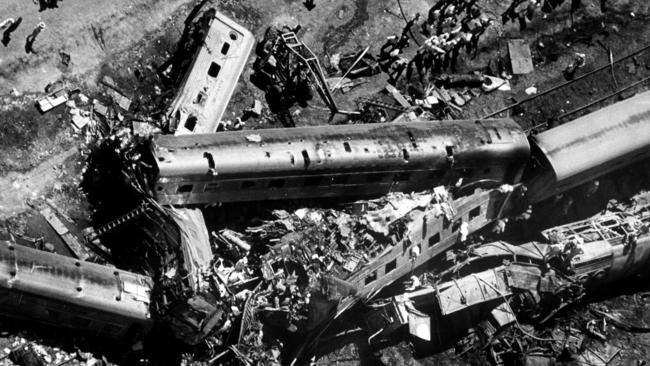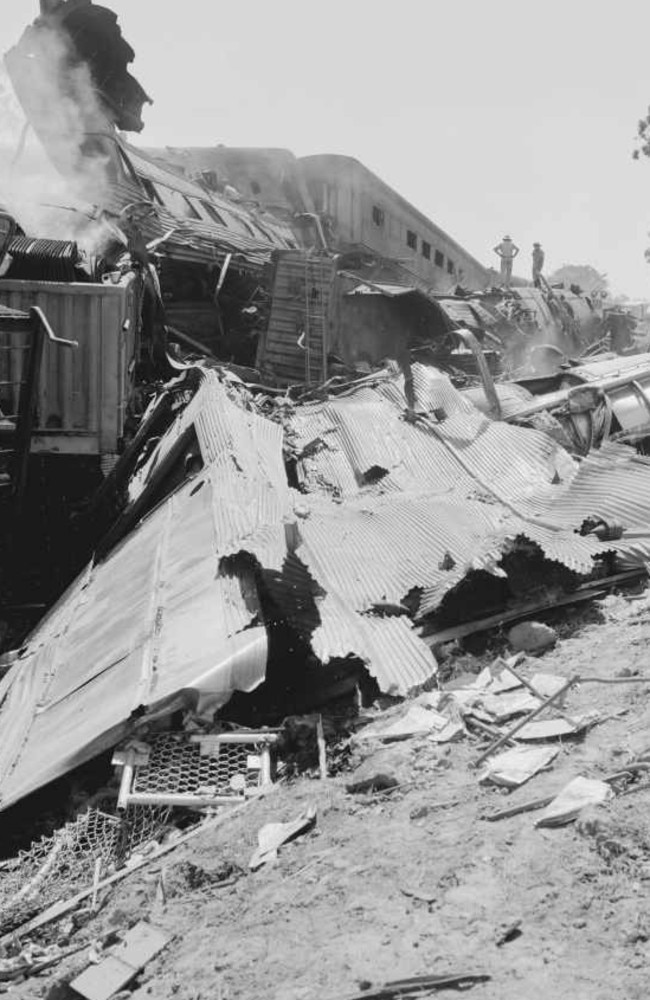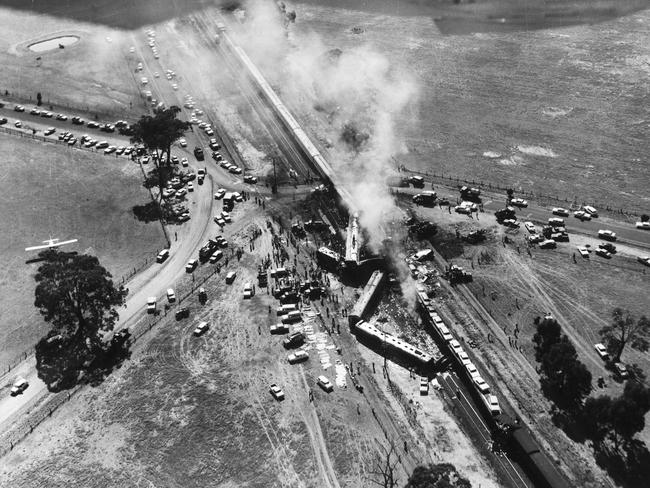Southern Aurora train crash: how Violet Town’s people shone when disaster struck in 1969
PEOPLE power came through when the Southern Aurora and a goods train collided in Violet Town in 1969. The deadly crash killed nine but volunteers saved many more lives.

VIC News
Don't miss out on the headlines from VIC News. Followed categories will be added to My News.
- Jaidyn Leskie: truth remains buried
- Which towns are Victoria’s hidden gems?
- Victoria’s 100 best restaurants
- Our history: Melbourne’s oldest buildings
THE sickening impact of the Southern Aurora ploughing into a goods train alerted the people of Violet Town to disaster before any CFA alarm could sound.
Like the passengers aboard the Southern Aurora, people in Violet Town were just beginning to greet the already hot morning on February 7, 1969, when the trains collided at a level crossing on the edge of town, about 170km northeast of Melbourne.
“The tremendous crash rocked buildings in Violet Town,” a Herald report from that day said.
The quick actions of emergency workers, many of them volunteers, and residents who flocked to help saved many lives amid the Southern Aurora’s twisted, smouldering carriages.
The driver of the sleek passenger express had been dead for at least 10 minutes before the crash.
John Bowden, 52, had a heart attack and died slumped over the Southern Aurora’s controls.

The train, carrying its crew and about 190 passengers, shot through the Violet Town crossing loop, where it should have stopped to allow an Albury-bound goods service to pass.
Instead, the Southern Aurora rumbled past a red signal at 110km/h.
The goods train’s fireman cheated death, jumping from the goods locomotive moments before the impact but the driver, Lawrence Rosevear of Wodonga, died at the brakes, bravely trying to avert the collision.
Nine people were killed, including the two drivers, a conductor, a railway electrician and five passengers, and 117 people were injured in the horrific tangle of wreckage.
The Southern Aurora’s power van burst into flames on impact and set fire to several mangled carriages but, within minutes, rescuers doused the flames.
Les Collier was travelling home to Kalgoorlie from a cruise that had berthed in Sydney.

Mr Collier said his carriage did “kangaroo hops” as the crash happened.
“Our car took right off the rails and came down on the car in front,” he told the Herald at the scene.
“We looked out the window and saw fire shooting up the side of our roomette.”
With a friend, Tom Watson, the family smashed through a window and climbed down with the help of other passengers.
“We had to get out as quickly as possible in case the whole carriage caught fire. There were smoke and flames everywhere,” he said.
WEST GATE: HOW A 10-YEAR-OLD BOY CAPTURED ONE OF MELBOURNE”S MOST TRAGIC IMAGES
The people of Violet Town, population 600, rallied along with emergency workers and passing motorists who stopped to help at the scene.
Others fed and comforted shocked passengers at a local hall, or assisted at a makeshift emergency depot and triage centre at a pub.

Heather Newell, just six at the time, was lucky to survive the crash, which claimed the lives of her mother Nora and sister Lorna.
“Mum had just woken me up and got me out of bed. I could see my 14-year old sister, Lorna, sitting up in her bed attached to the wall,” Ms Newell told the Herald Sun in 1994.
“Then everything went black. The next thing I remember, I was trapped in the carriage, with fire and smoke all around me and the smell of diesel fuel everywhere.
“I had no idea what had happened.”
Ms Newell was trapped for four hours with a broken leg, extensive bruising and superficial burns.
“I remember feeling really hot and I could see flames licking around this big pole that looked like an axle only a few feet to my right,” she said.
“There was this gaping hole in the carriage and I could see people on the other side of it walking around.
“I would see someone walk past and I’d yell `hey, mister,’ but there was so much noise, so much going on, no-one could hear me.
“I could hear the firemen pouring water on the flames above me, but the fire was so hot that by the time it (the water) got to me it was boiling and it burnt my skin.”

Fireman Charlie Shugg finally heard the little girl’s cries inside the carriage.
A former jockey, he was also the only one small enough to reach her inside the shattered carriage. He pulled the little girl free with her hair still smouldering.
“I had diesel engine oil in my lungs and somehow I had lost my nightie,” Ms Newell said.
“Charlie heard me calling. When he found me, he thought I was black because I was covered in diesel oil.”
THE DISASTERS THAT SHOCKED AUSTRALIANS IN THE 1970s
In an inquest later than year, coroner H.W. Pascoe found that Mr Bowden had ignored medical advice to retire.
He was told that his heart condition could kill him at any time.
But he reasoned that if he had a heart attack, there would be two other crew members qualified to stop the train in an emergency.
When push came to shove, that wasn’t so.

The inquest heard that the Southern Aurora’s fireman, Mervyn Coulthard, left the engine room and was brewing tea as the train rumbled past a red signal while the guard, William Wyer, admitted to dozing after the train left Albury. Both men survived.
Mr Pascoe found Mr Coulthard and Mr Wyer negligent, describing Mr Coulthard’s conduct as “incomprehensible”.
“Once the driver was dead, it needed only one of the two surviving crew to be attentive to his duty and this accident would never have happened,” Mr Pascoe said in his findings.
Mr Pascoe recommended annual medical tests and two-yearly electrocardiograms for drivers, modified vigilance controls in passenger locomotives to ensure both drivers and firemen were alert, new vigilance controls in guards’ vans to prevent guards from sleeping on duty, and new speedometers in guard vans to warn if a train was out of control.
A plaque now marks the spot where the Southern Aurora tragedy occurred, at the McDiarmids Road level crossing on Violet Town’s western edge.


